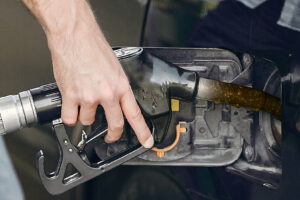Whenever the vehicle is driven, the fuel pump delivers fuel to the engine in order for the combustion process to occur. Any surplus fuel is returned to the tank via a return line.
Fuel is obtained from crude oil through a distillation process. This creates volatile organic compounds that evaporate at room temperature and stick to metal surfaces as brown, sticky residues. These can be easily recognized by viewing the tank filler neck.
These so-called rubber, resin and varnish residues can be found in the entire fuel system and ensure that the pipe cross-sections are tapered and ultimately the required flow rates can no longer be achieved.
This leads to the following problems:
• Reduced performance when towing or uphill driving.
• Rough start and rough idling.
• Sluggish acceleration or bad engine response.
• Complete failure of the engine.
• Dirty or blocked injectors can cause misfiring.
• The vehicle stutters and shakes at traffic lights or during traffic jams.

In the worst-case scenario, the vehicle can no longer be started.
An additional obstacle to a smooth running engine is condensation. When you operate your vehicle, the fuel level in the tank is reduced. Fresh air is sucked in to enable pressure equalization in the system. Depending on the weather conditions, there is a greater or lesser amount of moisture in the air, which condenses due to slight temperature differences (day / night). Thus, water deposits form in the fuel tank, which are spread throughout the system via the fuel pump.
The results are:
Since water has no lubricating properties, there is increased wear and tear on all parts due to insufficient lubrication.
• Increased wear on all parts due to insufficient lubrication.
• Injectors can start to stick.
• Engine running rough.
• Problematic fuel pump.
With the introduction of unleaded fuel, lead was replaced by alcohol. These are also called alcohol fuels. Since alcohol is hygroscopic, the water deposits in the tank remove the alcohol from the fuel, causing the fuel to lose its resistance to engine knocking. A chemical reaction between water and fuel thus creates an aggressive water-fuel mixture.
Experts warn against damage to components made of aluminum, with an increased mixture of water and alcohol (also when using E10 fuels). Ultimately, this is due to the corrosive effect of the aggressive alcohol in the water mixture as well as bioethanol. This also leads to increased wear on the valves and valve seat inserts. The effect on plasticizers in rubber and plastic parts can also lead to porous and brittle components.
In the long run, there will be customer complaints about engine performance. The workshop tries to find the fault and begins to replace parts. However, since the cause is both the deposits from the oxidized fuel in the fuel system and the aggressive alcohol-water mixture, the customer will return to the workshop unsatisfied as the real problem has not been addressed.
There are high costs and time-consuming searches associated with this fault.
There are high costs and time-consuming searches associated with this fault.
With our fuel system cleaner, all those problems are a thing of the past.
The fuel system cleaner binds water and fuel into a stable and highly lubricating emulsion. Water burns like normal fuel. In addition, the product dissolves all rubber, resin and varnish residues in the entire system in a molecularly fine manner so that they are safely removed during combustion. The fuel system is optimally lubricated, manufacturer-specific fuel flow specifications are ensured and the injection nozzles work like new.
The product is simply added to the fuel system every 10,000 km.
One application contains 375ml and is sufficient for up to 80 liters of fuel.
This product has been successfully tested for effectiveness by TÜV Thuringia. In addition, tests performed by accredited independent institutions have shown that our product is fully compatible with all components and modes of operation in the fuel system.
“bluechemGROUP in harmony with vehicles and the environment.”
Author:
Josef Kluy
(Professor h.c. Westpoint China Automotive Technical College)
International Business Development


